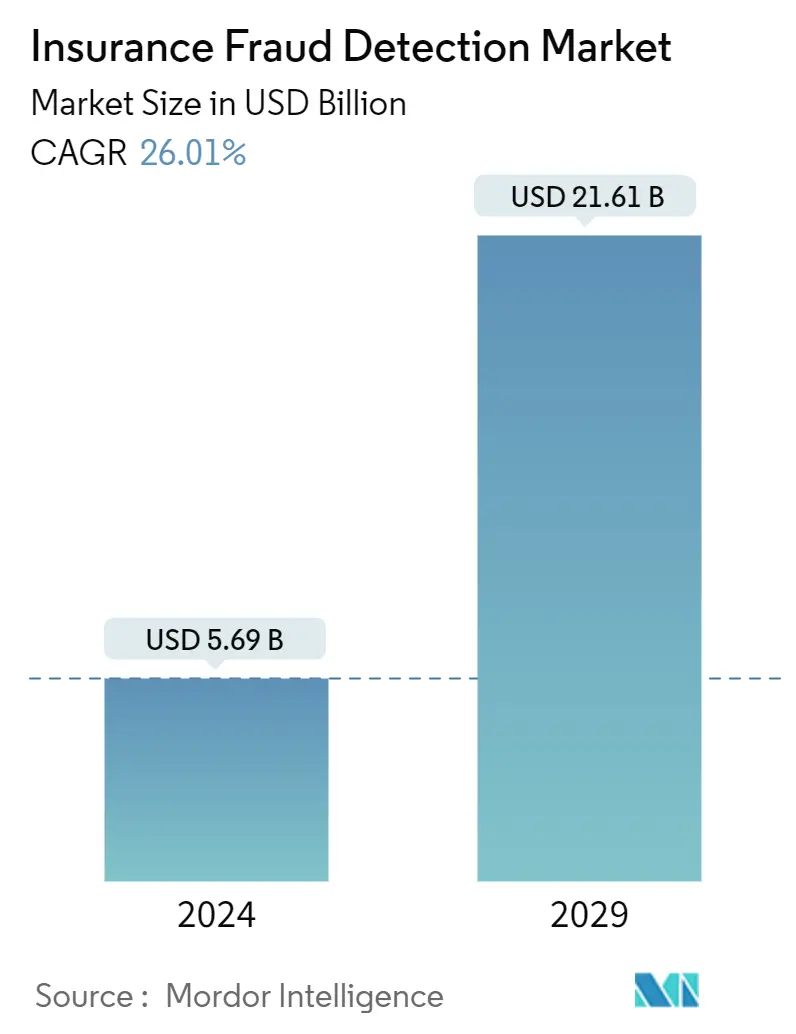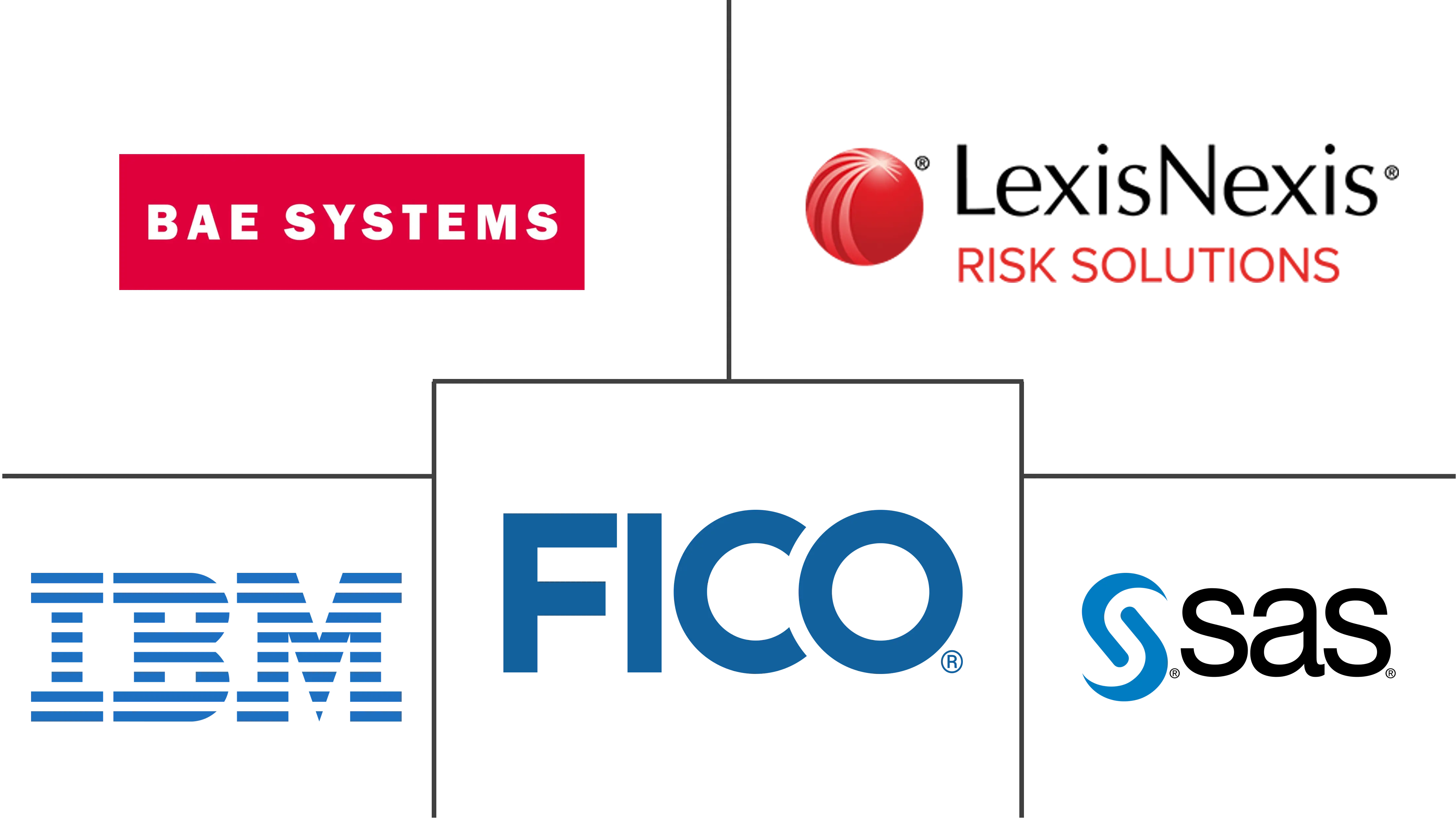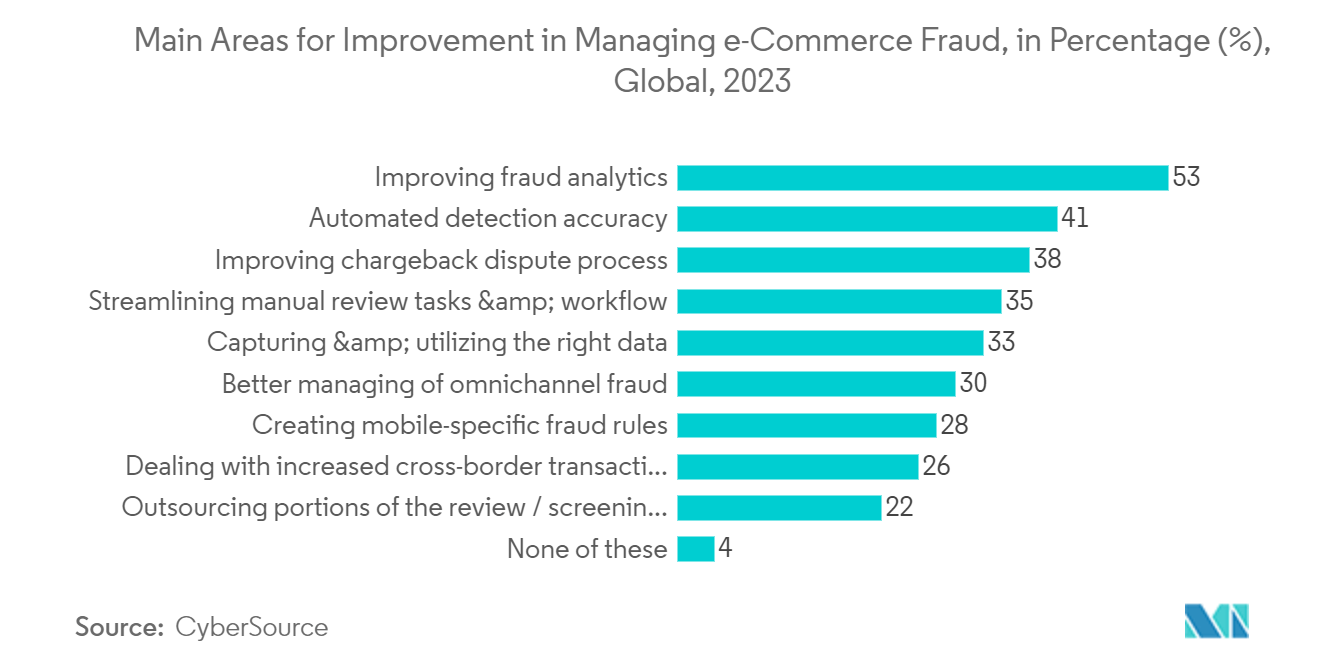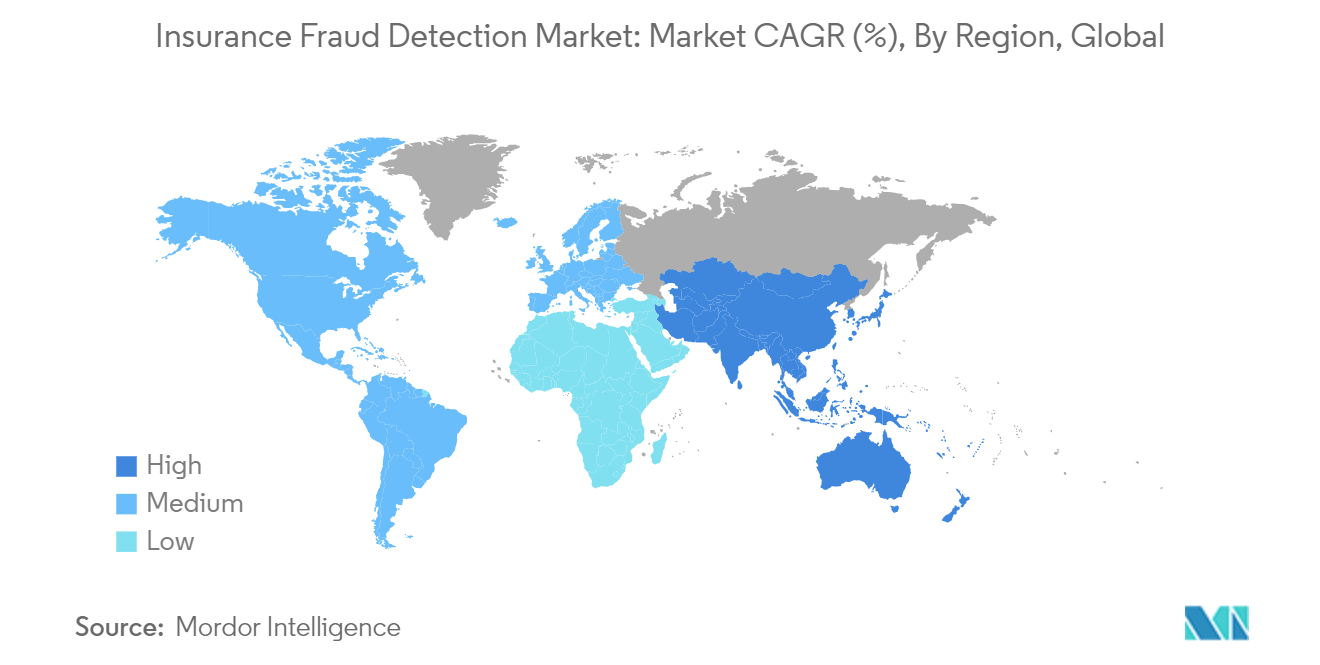Insurance Fraud Detection Market Size

| Study Period | 2019-2029 |
| Market Size (2024) | USD 5.69 Billion |
| Market Size (2029) | USD 21.61 Billion |
| CAGR (2024 - 2029) | 26.01 % |
| Fastest Growing Market | Asia Pacific |
| Largest Market | North America |
Major Players
*Disclaimer: Major Players sorted in no particular order |
Insurance Fraud Detection Market Analysis
The Insurance Fraud Detection Market size is estimated at USD 5.69 billion in 2024, and is expected to reach USD 21.61 billion by 2029, growing at a CAGR of 26.01% during the forecast period (2024-2029).
The increasing number of fraud claims and their burden on insurance businesses, the need to efficiently manage large amounts of policyholder data, and improved operational efficiency to enhance customer experience are the key factors fueling the market's growth.
- The insurance industry's embrace of automation has paced the application processing, underwriting, and claims processes and opened ways to new fraud types throughout the insurance life cycle. The digital shift gave rise to digital experiences and automated premium calculation processes, opening new opportunities for fraudsters. Thus, the use of AI insurance fraud tools is growing considerably.
- The need to effectively manage vast volumes of identities plays a pivotal role in shaping the insurance fraud detection market, reflecting the industry's response to the evolving challenges posed by identity-related risks. As the insurance sector undergoes digital transformation, the large volume and diversity of identities involved in transactions, claims processing, and interactions have risen. This surge in data complexity necessitates a sophisticated approach to identity management, making it a critical market driver for insurers.
- Improved operational efficiency and enhanced customer experience represent a comprehensive approach within the insurance fraud detection market. It signifies a shift from traditional, segregated fraud prevention methods to a more integrated strategy prioritizing the insurer's internal workings and the policyholder's external experience.
- The insurance industry's awareness and comprehension of these technologies are crucial for the efficacy of fraud detection systems in the current landscape of rapid technological developments and shifting fraud strategies. However, widespread ignorance might pose a significant barrier to adopting and effectively applying advanced fraud detection technologies.
- The COVID-19 pandemic had a long-term impact on several industries, notably the market for insurance fraud detection. The insurance sector witnessed changes in fraudulent activity patterns as the world faced previously unrecognized challenges, which led to a reassessment of fraud detection techniques.
- The COVID-19 pandemic accelerated digitalization in the insurance business, providing the sector with improved instruments to fight fraud across the policy lifecycle. As per FRISS's survey, which involved 400 insurance professionals worldwide, 53% anticipated that anti-fraud technology would aid them in remaining ahead of emerging fraudulent schemes. In contrast, 52% look forward to enhanced investigator efficiency. As per a recent FRISS survey, for 59% of respondents in the insurance sector, fraud detection software is expected to enhance the loss ratio. The increased adoption of digital tools and technology, as indicated by improved tools to fight fraud, reflects the industry's response to the challenges posed by the dynamic fraud landscape during and after the pandemic.
Insurance Fraud Detection Market Trends
Fraud Analytics Solution Segment is Expected to Hold Significant Market Share
- Insurance fraud analytic solutions can improve the accuracy of fraud detection, leveraging the capabilities of artificial intelligence (AI), machine learning, and predictive modeling, which could be helpful for the user to identify instances of suspicious behavior and proactively protect themselves against fraudulent claims, driving the demand of the insurance fraud analytics solutions in the market.
- Insurers have been paying a significant amount for fraudulent claims annually, increasing the importance of insurance fraud detection and creating an opportunity for the market's growth in countries worldwide. For instance, in June 2023, the City of London Police's Insurance Fraud Enforcement Department (IFED) published data collected about insurance fraud between March 2022 and April 2023. It stated that the country had witnessed an increase of 61% in insurance fraud during the study period, which shows the increasing risk of insurance fraud in the end users, fueling the need for insurance fraud analytic solutions in the market.
- Market vendors provide insurance fraud analytic solutions, including FICO, IBM, Genpact, etc. Using predictive modeling to identify, score, and prioritize possible fraud cases can reduce insurers' fraudulent claims payouts and help them avoid reputational damage or loss of customers because of premium increases, fueling the demand of the market.
- By end user, the BFSI sector, which includes the insurance sector, drives the insurance fraud analytics solutions market growth due to their applications in protecting the insurance companies' business from fraudulent claims.
- For instance, in May 2023, Teradata and FICO, the analytics software provider in the insurance claim market, partnered to bring to market integrated advanced analytic solutions for real-time payments fraud insurance claims by incorporating AI-powered decision automation and optimization to financial services, which shows the demand for fraud analytical solutions in the BFSI sector.
- Digitalization in the banking, insurance, and healthcare sectors is supporting the market's growth due to the availability of online data. Due to the digitalization process, it is helpful for end users to adopt fraud analytic solutions for better risk management, which is expected to drive the market's growth during the forecast period.

North America to Hold Largest Market Share
- The market growth in the country is driven by the growing number of younger Americans who are increasingly subjected to insurance fraud, where they are generally more tolerant of non-fraudulent crimes. Younger Americans view insurance fraud as a cost of doing business with insurance companies. Due to this, insurance businesses incur losses with fraud claims. To minimize these losses, insurance companies tend to adopt these solutions.
- According to the Coalition Against Insurance Fraud, insurance fraud costs the United States more than USD 308 billion annually. The Federal Bureau of Investigation (FBI) estimates that insurance fraud costs an average family between USD 400 and 700 in premiums annually. With the growing adoption of technology and the emergence of new capabilities such as generative AI, the threat of fraud is expected to increase.
- The increase in successful fraud tends to make consumers pay the price. Insurance companies are forced to pass the cost of fraud on to consumers through higher insurance premiums, impacting various aspects of the economy. For instance, employers must increase insurance premiums due to fraud. Thus, to respond to these challenges, insurance companies are adopting fraud detection solutions.
- With the rapidly increasing sophistication of insurance fraud in Canada, identifying suspicious claims efficiently and preventing insurance fraud during claims adjudication has become essential for insurance businesses. Thus, companies such as TD Insurance expanded their manual and analytics-based fraud detection and prevention capabilities by implementing the FRISS Case Management Tool and Claims Fraud Detection solution to efficiently identify suspicious and fraudulent claims during the claims adjudication procedure.
- The overall cost of insurance in Canada has been rising in recent years, putting pressure on insurance companies to control expenses and reduce losses. For instance, car insurance premiums increased to 4.6% nationwide due to inflation, as per the latest price index. As the prices of vehicles increase, the cost of car insurance increases. This leads to increased use of fraud detection solutions by insurance businesses that offer insurance to the automotive sector to maintain profitability.
- In October 2023, the Équité Association launched a national insurance crime detection platform that uses predictive analytics and machine learning (ML) to detect and prevent insurance fraud. This platform leverages a consortium-based approach to commit insurance-related crimes, which cost Canadians an estimated USD 3 billion to USD 5 billion annually. Such launch of new platforms is anticipated to encourage vendors to introduce new solutions, increasing competition in the market. The Canadian insurance fraud detection market is mainly driven by initiatives by insurance businesses to minimize losses by claim frauds and the shift toward analytics-based fraud detection solutions that help them offer better consumer experience to policyholders.

Insurance Fraud Detection Industry Overview
The insurance fraud detection market is highly fragmented with the presence of major players like Fair Isaac Corporation (FICO), BAE Systems Inc., IBM Corporation, SAS Institute Inc., and Experian Information Solutions Inc. Players in the market adopt strategies such as partnerships and acquisitions to enhance their product offerings and gain sustainable competitive advantage.
- November 2023 - FRISS announced the launch of the RISS Accelerator for Claims Analytics for ClaimCenter Cloud. With this launch, the company leverages the latest capabilities of the Guidewire Cloud Integration Framework, which is now available in the Guidewire Marketplace to ClaimCenter users on Guidewire Cloud.
- January 2023 - Experian announced that the company had launched CreditLock, a new feature that enables its customers to lock their Experian Credit Report. The new product launched by the company uses real-time alerts. The feature will also let customers know about any new credit searches in their name and if it has stopped any fraudulent applications on their behalf.
Insurance Fraud Detection Market Leaders
-
Fair Isaac Corporation (FICO)
-
BAE Systems Inc.
-
IBM Corporation
-
SAS Institute Inc.
-
Experian Information Solutions Inc.
*Disclaimer: Major Players sorted in no particular order

Insurance Fraud Detection Market News
- May 2023 - Insurance data analytics provider Verisk partnered with CCC Intelligent Solutions, a cloud platform for the P&C insurance market, to address the risk of insurance fraud. The partnership will integrate Verisk's claims fraud detection analytics with CCC's claims platform.
- March 2023 - Shift Technology, a provider of AI-driven decision automation and optimization solutions for the global insurance industry, introduced the General Insurance Association of Singapore (GIA), which will be extending its usage of Shift Claims Fraud Detection on behalf of its member insurers. This strategic expansion builds on the successes of the GIA Fraud Management System (FMS) and will assist travel insurance fraud. This planned expansion allows them to maximize the potential of the travel module and comes at an opportune time to increase global travel. The collaboration with Shift gives them an important way to detect and manage fraudulent claims at scale. It also augments their sector's existing fraud detection and management efforts.
Insurance Fraud Detection Market Report - Table of Contents
1. INTRODUCTION
- 1.1 Study Assumptions and Market Definition
- 1.2 Scope of the Study
2. RESEARCH METHODOLOGY
3. EXECUTIVE SUMMARY
4. MARKET INSIGHTS
- 4.1 Market Overview
- 4.2 Industry Stakeholder Analysis
-
4.3 Industry Attractiveness - Porter's Five Forces Analysis
- 4.3.1 Bargaining Power of Suppliers
- 4.3.2 Bargaining Power of Consumers
- 4.3.3 Threat of New Entrants
- 4.3.4 Threat of Substitute Products
- 4.3.5 Intensity of Competitive Rivalry
5. MARKET DYNAMICS
-
5.1 Market Drivers
- 5.1.1 Need to Effectively Manage Huge Volumes of Identities
- 5.1.2 Improved Operational Efficiency and Enhanced Customer Experience
-
5.2 Market Restraints
- 5.2.1 Lack of Awareness Regarding Fraud Detection Solutions
- 5.3 Impact of COVID-19 in Insurance Fraud Industry
6. MARKET SEGMENTATION
-
6.1 By Component
- 6.1.1 Solution
- 6.1.1.1 Fraud Analytics
- 6.1.1.2 Authentication
- 6.1.1.3 Governance, Risk, and Compliance
- 6.1.1.4 Other Solutions
- 6.1.2 Service
-
6.2 By Applcation
- 6.2.1 Claims Fraud
- 6.2.2 Identity Theft
- 6.2.3 Payment and Billing Fraud
- 6.2.4 Money Laundering
-
6.3 By End-user Indsutry
- 6.3.1 Automotive
- 6.3.2 BFSI
- 6.3.3 Healthcare
- 6.3.4 Retail
- 6.3.5 Other End-user Industries
-
6.4 By Geography
- 6.4.1 North America
- 6.4.1.1 United States
- 6.4.1.2 Canada
- 6.4.2 Europe
- 6.4.2.1 United Kingdom
- 6.4.2.2 Germany
- 6.4.2.3 France
- 6.4.3 Asia-Pacific
- 6.4.3.1 China
- 6.4.3.2 Japan
- 6.4.3.3 India
- 6.4.3.4 Rest of Asia Pacific
- 6.4.4 Latin America
- 6.4.5 Middle East and Africa
7. COMPETITIVE LANDSCAPE
-
7.1 Company Profiles
- 7.1.1 Fair Isaac Corporation (FICO)
- 7.1.2 BAE Systems Inc.
- 7.1.3 IBM Corporation
- 7.1.4 SAS Institute Inc.
- 7.1.5 Experian Information Solutions Inc.
- 7.1.6 Lexisnexis Risk Solutions Inc. (Relx Group PLC)
- 7.1.7 SAP SE
- 7.1.8 Fiserv Inc.
- 7.1.9 FRISS Fraudebestrijding BV
- *List Not Exhaustive
8. INVESTMENT ANALYSIS
9. MARKET OPPORTUNITIES AND FUTURE TRENDS
** Subject To AvailablityInsurance Fraud Detection Industry Segmentation
Insurance fraud detection software prevents, detects, and manages fraud across the enterprise, making smarter decisions, increasing return on capital, and driving business performance. The global insurance fraud detection market is defined based on the revenues generated from the solutions and services used by various end users across the globe. The analysis is based on the market insights captured through secondary research and the primaries. The market also covers the major factors impacting the market’s growth in terms of drivers and restraints.
The insurance fraud detection market is segmented by component (solution [fraud analytics, authentication, governance, risk, and compliance, and other solutions] and service), by application (claims fraud, identity theft, payment and billing fraud, and money laundering), by end-user industry (automotive, BFSI, healthcare, and retail), and by geography (North America [United States and Canada], Europe [United Kingdom, Germany, France, and Rest of Europe], Asia-Pacific [China, Japan, India, and Rest of Asia Pacific], Latin America, and Middle East and Africa). The report offers market forecast and size in USD for all the above segments.
| By Component | Solution | Fraud Analytics |
| Authentication | ||
| Governance, Risk, and Compliance | ||
| Other Solutions | ||
| By Component | Service | |
| By Applcation | Claims Fraud | |
| Identity Theft | ||
| Payment and Billing Fraud | ||
| Money Laundering | ||
| By End-user Indsutry | Automotive | |
| BFSI | ||
| Healthcare | ||
| Retail | ||
| Other End-user Industries | ||
| By Geography | North America | United States |
| Canada | ||
| By Geography | Europe | United Kingdom |
| Germany | ||
| France | ||
| By Geography | Asia-Pacific | China |
| Japan | ||
| India | ||
| Rest of Asia Pacific | ||
| By Geography | Latin America | |
| Middle East and Africa |
Insurance Fraud Detection Market Research FAQs
How big is the Insurance Fraud Detection Market?
The Insurance Fraud Detection Market size is expected to reach USD 5.69 billion in 2024 and grow at a CAGR of 26.01% to reach USD 21.61 billion by 2029.
What is the current Insurance Fraud Detection Market size?
In 2024, the Insurance Fraud Detection Market size is expected to reach USD 5.69 billion.
Who are the key players in Insurance Fraud Detection Market?
Fair Isaac Corporation (FICO), BAE Systems Inc., IBM Corporation, SAS Institute Inc. and Experian Information Solutions Inc. are the major companies operating in the Insurance Fraud Detection Market.
Which is the fastest growing region in Insurance Fraud Detection Market?
Asia Pacific is estimated to grow at the highest CAGR over the forecast period (2024-2029).
Which region has the biggest share in Insurance Fraud Detection Market?
In 2024, the North America accounts for the largest market share in Insurance Fraud Detection Market.
Insurance Fraud Detection Industry Report
The Insurance Fraud Detection Software Market report provides a comprehensive market overview, focusing on key industry trends and market segmentation. The report is segmented by component, including solutions such as fraud analytics, authentication, governance, risk, and compliance, as well as other solutions and services. It also covers various applications like claims fraud, identity theft, payment and billing fraud, and money laundering. The end-user industries analyzed include automotive, BFSI, healthcare, retail, and others, with geographical segmentation spanning North America, Europe, Asia-Pacific, Latin America, and the Middle East and Africa.
This industry report offers valuable market data, presenting an industry outlook with detailed market analysis. The report includes industry statistics and market value, providing insights into the market size and market growth. It also features an industry overview and market forecast, highlighting market trends and market predictions for the future.
The market research delves into the industry sales and market review, identifying market leaders and their market share. The industry information provided in the report is crucial for understanding the market dynamics and growth rate. The report example and report PDF serve as useful resources for further industry research, offering a detailed market segmentation and industry analysis.
Overall, this report is an essential tool for research companies and stakeholders looking to gain a deeper understanding of the Insurance Fraud Detection Software Market. It provides a thorough market outlook and industry reports, ensuring a well-rounded perspective on the market's current state and future potential.



